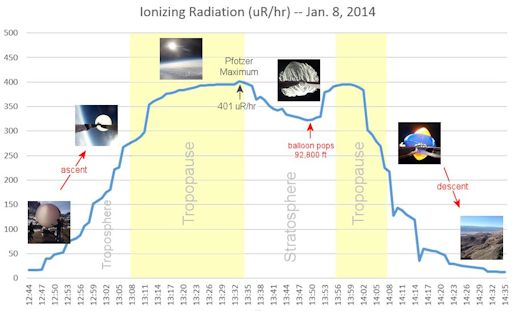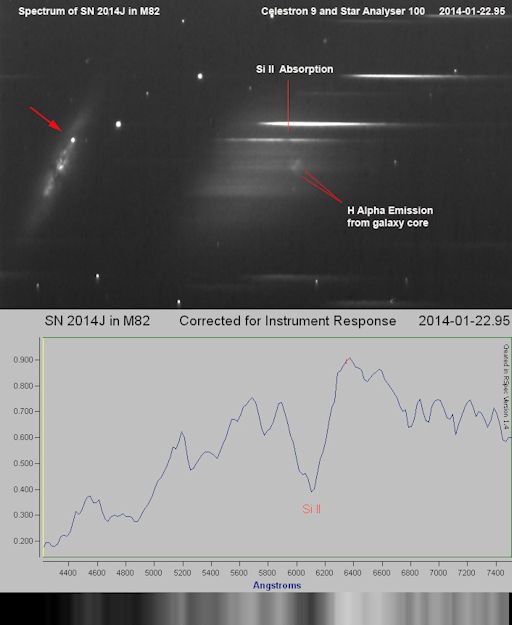When is the best time to see auroras? Where is the best place to go? And how do you photograph them? These questions and more are answered in a new book, Northern Lights - a Guide, by Pal Brekke & Fredrik Broms. | | | QUIET SUN: With no sunspots actively flaring, the sun's x-ray output has flatlined. Solar activity is low and likely to remain so for the rest of the weekend. Solar flare alerts: text, voice SPACE WEATHER BALLOON LAUNCH TODAY: The students of Earth to Sky Calculus are only hours away from launching another space weather balloon. The launch, slated for midday Pacific time on Jan. 25th, is the latest in a series of suborbital balloon missions designed to study the effects of solar activity on Earth's upper atmosphere. Today's flight samples a period of low solar activity, the opposite of their previous flight, which flew into the teeth of an S2-class solar radiation storm. Here are the storm data they gathered on Jan. 8th: 
The curve traces the amount of ionizing radiation encountered by the balloon during its 2 hour flight. During the ascent, an onboard x-ray/gamma-ray sensor measured doses 25 times greater than at ground level. The peak occured at the entrance to the stratosphere in a zone known as the "Pfotzer Maximum." Named after physicist George Pfotzer, who discovered the peak using balloons and Geiger tubes in the 1930s, the Pfotzer Maximum is produced by energetic particles hitting Earth's atmosphere, creating a spray of subatomic debris at high altitudes. The Earth to Sky campaign aims to find out, among other things, how the Pfotzer Maximum moves around in response to solar storms. This weekend's flight will repeat the Jan. 8th experiment using the same equipment while no solar radiation storm is in progress. If all goes well, the balloon will also capture dramatic images of California's epic drought. Stay tuned for updates. Realtime Space Weather Photo Gallery BRIGHT, NEARBY SUPERNOVA: Approximately 12 million years ago, a white dwarf star in galaxy M82 exploded. A few days ago, light from the supernova finally reached Earth. Amateur astronomers can see it through backyard telescopes as a fireball of magnitude +11. Indeed, it is so bright that small telescopes can be used to study the specturm of the blast. David Strange sends these data from Branscombe, East Devon, UK: 
"I used a 9-inch Celestron telescope and a Star Analyzer 100 to record the supernova's colors," says Strange. His data show a strong absorption line corresponding to ionized silicon. Silicon is one of the products of fusing carbon and oxygen, and a telltale sign that this is a Type 1a supernova explosion. Type 1a supernovas are famous in part because they led to the discovery of Dark Energy in the universe. (And, yes, we know that "Dark Energy" is shorthand for "we don't know what's going on.") Although it is 12 million light years away, M82 is considered to be a next-door neighbor of the Milky Way. Indeed, this is the nearest supernova to Earth since SN 1993J was observed 21 years ago. The relative proximity of the blast makes it an attractive target for astronomers to study. Light curves from previous Type 1a supernovas suggest that the fireball could continue to brighten for the next two weeks. If you have a GOTO telescope, this evening command it to slew to the "cigar galaxy" or "M82," and watch the explosion unfold. Realtime Supernova Photo Gallery
Realtime Aurora Photo Gallery
Realtime Venus Photo Gallery
Realtime Comet Photo Gallery
Every night, a network of NASA all-sky cameras scans the skies above the United States for meteoritic fireballs. Automated software maintained by NASA's Meteoroid Environment Office calculates their orbits, velocity, penetration depth in Earth's atmosphere and many other characteristics. Daily results are presented here on Spaceweather.com. On Jan. 24, 2014, the network reported 10 fireballs.
(10 sporadics) 
In this diagram of the inner solar system, all of the fireball orbits intersect at a single point--Earth. The orbits are color-coded by velocity, from slow (red) to fast (blue). [Larger image] [movies] On Jan. 23, 2014, the network reported 11 fireballs.
(9 sporadics, 2 xi Coronae Borealids) 
In this diagram of the inner solar system, all of the fireball orbits intersect at a single point--Earth. The orbits are color-coded by velocity, from slow (red) to fast (blue). [Larger image] [movies] Potentially Hazardous Asteroids ( PHAs) are space rocks larger than approximately 100m that can come closer to Earth than 0.05 AU. None of the known PHAs is on a collision course with our planet, although astronomers are finding new ones all the time. On January 25, 2014 there were potentially hazardous asteroids. Notes: LD means "Lunar Distance." 1 LD = 384,401 km, the distance between Earth and the Moon. 1 LD also equals 0.00256 AU. MAG is the visual magnitude of the asteroid on the date of closest approach. | | The official U.S. government space weather bureau | | | The first place to look for information about sundogs, pillars, rainbows and related phenomena. | | | Researchers call it a "Hubble for the sun." SDO is the most advanced solar observatory ever. | | | 3D views of the sun from NASA's Solar and Terrestrial Relations Observatory | | | Realtime and archival images of the Sun from SOHO. | | | from the NOAA Space Environment Center | | | the underlying science of space weather | | 
